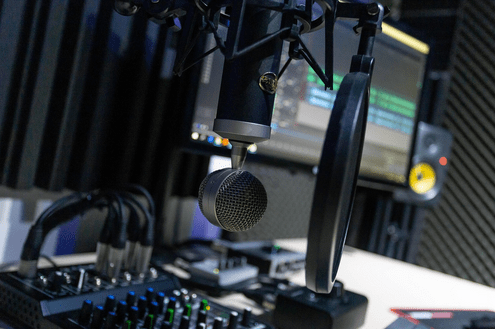Sustainable Broadcasting Equipment: Eco-Friendly Solutions for Studios

Reduce Studio Power Consumption & Save Money
Every studio has the same problem at the moment. Energy prices are through the roof and the demand for green credentials is coming from every direction.
According to recent figures from the BBC broadcasting is responsible for more than 2% of global CO2 emissions.
That’s the same as the entire aviation industry.
Fortunately, new modern broadcasting equipment solutions are making it easier than ever to broadcast green. Sustainable and energy-efficient technology from companies like Thor Broadcast is helping to green studios reduce carbon emissions without compromising on broadcast quality.
The best part…
Saving the planet isn’t the only benefit of going green. It’s also good for the wallet.
What you’ll learn:
- Why sustainable broadcasting equipment matters
- The best eco-friendly solutions for modern studios
- How energy-efficient equipment saves money and emissions
- Tips to green your own broadcasting setup today
Why Sustainable Broadcasting Equipment Matters
Let’s start with the obvious.
Broadcasting is an energy-guzzling industry by its very nature. Lots of power is required just to light a studio, run cameras and keep the transmission, server and cooling equipment operating.
But things are changing. Broadcasters are under increasing pressure to go green to stay competitive and meet regulations.
ESG is the new normal and your audience, investors and regulators all care about your carbon footprint.
Here’s the brutal truth…
Ignoring the demand for sustainability isn’t an option anymore. Studios that fail to act are going to get left behind.
But studios that act to improve sustainability? They are reaping the rewards of lower operating costs and improved brand perception.
Energy Efficient Transmitters & Encoders
Here’s a dirty secret most studios don’t realize…
Your transmission equipment is eating your energy budget. Transmitters in particular are some of the most energy-inefficient equipment in any studio.
Old-school transmitters typically only convert 15-20% of input power to usable output power. All the rest is wasted.
Energy-efficient transmitters are a game-changer with some models offering efficiency as high as 30-40% or more.
That’s cutting your transmission power consumption in half! The running cost savings add up quickly.
The same is true for encoders. More efficient compression algorithms reduce bandwidth requirements and energy use across the whole delivery chain.
LED Lighting Systems
There’s an easy fix for this…
Replace old inefficient lighting.
LED lighting systems consume a fraction of the power of traditional studio lights. Plus, they emit less heat so your cooling systems can run at lower levels too.
It’s the cascading effect that really makes a difference. Lower heat output from lighting means your HVAC equipment can run more efficiently. Lower HVAC costs mean a smaller carbon footprint.
LEDs also last many times longer than traditional lights so your replacement and waste disposal costs drop too.
Renewable Energy Integration
Solar panels are the future…
More and more studios are going solar by installing panels on studio roofs and integrating with renewable energy sources. Net-zero emissions is becoming a realistic target for some studios by generating their own renewable energy on-site.
Solar power can offset a huge percentage of your day-time energy use. Surplus power can even be sold back to the grid and you get paid for it!
Solar technology is cheaper and more efficient than ever. Studio roofs are effectively free land to generate your own clean power. What was impossible 10 years ago is now becoming a baseline expectation for modern studios.
Cloud-Based Production Solutions
Cloud technology is transforming sustainable broadcasting.
Moving production workflows to cloud platforms allows studios to shrink their on-premises hardware footprint. Less equipment to power, cool and dispose of means lower energy costs and carbon emissions.
Cloud providers run mega data centers that are orders of magnitude more energy-efficient than traditional on-premises server rooms. Specialized cooling, high-efficiency hardware, dynamic resource allocation and a growing shift to 100% renewable energy power cloud data centers.
Remote production reduces travel and travel-related emissions too. Distributed teams can collaborate from home or office instead of traveling to locations and lugging equipment around.
Virtual Production Technologies
Virtual production is not just a cool new technology.
LED walls and greenscreen environments are revolutionizing production. Instead of shooting on location with full crews and equipment, virtual production builds any environment inside the studio.
No travel emissions from planes and vehicles, no shipping equipment around, no need for temporary power generation and far less material waste from constructing physical sets.
Research shows virtual production has the potential to slash carbon emissions by as much as 50% compared to traditional location shooting.
Monitoring & Measurement Tools
If you can’t measure it, you can’t manage it.
Real-time monitoring tools are the new must-have sustainability accessory. Track your carbon footprint in real time and get instant visibility into energy use and emissions.
Some tools integrate with production workflows to automatically calculate the carbon impact of each project. Transparency makes it easier for studios to improve and report accurate metrics to stakeholders and clients.
It’s actually not that complicated when you get started.
Equipment Lifecycle Management
Green isn’t just how equipment performs once it’s in the studio.
Sustainability needs to be considered across the whole equipment lifecycle. This includes:
- Design and manufacturing
- Use phase operations and energy use
- Refurbishment and reuse potential
- Recycling and e-waste disposal
Smart studios are buying gear built with recyclable materials, working with manufacturers who prioritize sustainable production, refurbishing and upgrading existing gear instead of buying new and properly recycling old gear.
Switching To Sustainable Equipment
Ok, so how do you actually make the switch to green equipment?
It’s easier than you think to start. Begin by conducting an energy audit to see where you have the biggest energy consumers. Upgrade the easiest wins first – often lighting and cooling have the fastest return.
Research energy certified and sustainable equipment from manufacturers that are committed to green production practices.
Don’t try to do it all at once.
Phase your switch to sustainable equipment over time. LED lighting upgrades are a low-hanging fruit that can often be followed by efficient encoders and transmitters and eventually renewable energy.
Work with partners who understand sustainability. Find suppliers that are experts in green equipment and can guide and advise you on the transition. The right partners can make all the difference in reaching your sustainability goals.
The Bottom Line
Sustainable broadcasting equipment is not a thing of the future. It’s available now and studios are already reaping the benefits of lower running costs and lower environmental impact.
The tech has advanced to the point where going green no longer means sacrifice on performance or quality. In many cases, more efficient, sustainable equipment actually outperforms traditional alternatives.
The question is not whether your studio should consider green solutions.
The question is how quickly you can make the change before your competitors get there first.
Start with one small improvement and build momentum as you start to see the rewards. Your bottom line and the planet will thank you.
Ready to transform your studio? The solutions and technology are all available now. You just need to take the first step to a more sustainable future.


